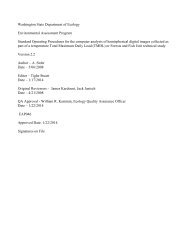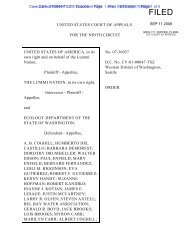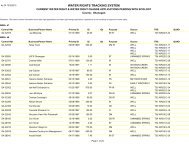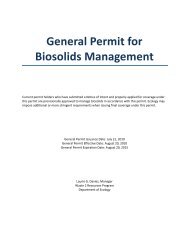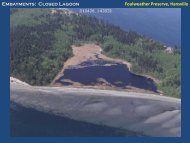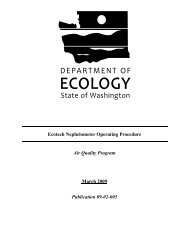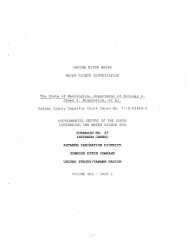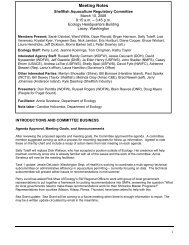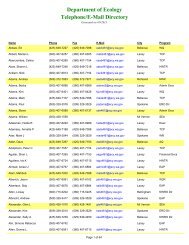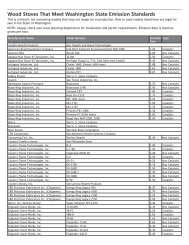WRIA 62 WMP 032305 - Washington State Department of Ecology
WRIA 62 WMP 032305 - Washington State Department of Ecology
WRIA 62 WMP 032305 - Washington State Department of Ecology
You also want an ePaper? Increase the reach of your titles
YUMPU automatically turns print PDFs into web optimized ePapers that Google loves.
March, 2005 -97- 023-1289-003.3040<br />
6.7 Funding<br />
The <strong>WRIA</strong> <strong>62</strong> Watershed Planning Unit considers this working plan and, as such, additional actions<br />
for implementation may arise in the future once projects are implemented, data collected and issues<br />
better understood. In order to implement the actions in this plan and continue development <strong>of</strong><br />
concepts into new actions for implementation, annual funding will be required. The following<br />
paragraphs provide a description <strong>of</strong> funding sources. The actual costs <strong>of</strong> Plan implementation will be<br />
determined in Phase IV.<br />
Phase IV implementation funds that include:<br />
<strong>WRIA</strong> <strong>62</strong> <strong>WMP</strong> <strong>032305</strong><br />
• Up to $100,000 for the first three years <strong>of</strong> implementation, with a 10% required<br />
match ($11,111 per year). Second and third year funding is conditioned on the<br />
completion <strong>of</strong> an approved Detailed Implementation Plan.<br />
• At the end <strong>of</strong> three years, up to $50,000 for the fourth and fifth years <strong>of</strong><br />
implementation, with a 10% required match ($5,556 per year).<br />
Matching funds may include financial contributions, in-kind goods and services (including volunteer<br />
services).<br />
The <strong>WRIA</strong> <strong>62</strong> Watershed Planning Unit also recommends that the Legislature consider making<br />
supplemental funding associated with Phase II Planning available for use in Phase IV Implementation<br />
for those watersheds (such as <strong>WRIA</strong> <strong>62</strong>) that did not apply for supplemental Phase II funding for<br />
instream flow, water quality or storage planning elements. If the Legislature makes these funds<br />
available, an additional $300,000 ($100,000 each to support instream flow, water quality or storage<br />
assessments) may be available.<br />
Other potential funding sources are listed below. Additional potential funding sources are identified<br />
and described in Appendix K <strong>of</strong> this plan.<br />
• Specific grants that may be available through the <strong>Washington</strong> <strong>State</strong> <strong>Department</strong>s <strong>of</strong><br />
<strong>Ecology</strong>, Fish and Wildlife and Health that will vary over time.<br />
• Federal funding sources for monitoring, pollution prevention and control, watershed<br />
and drinking water source protection, wetlands and wildlife. These funding sources<br />
are compiled in EPA’s Catalog <strong>of</strong> Federal Funding Sources for Watershed<br />
Protection.<br />
• Centennial Clean Water Funds available through the <strong>Washington</strong> <strong>State</strong> <strong>Department</strong>s<br />
<strong>of</strong> <strong>Ecology</strong>.<br />
• Pend Oreille Salmonid Recovery Team with funding through the Salmon Recovery<br />
Funding Board (SRFB).<br />
• The Northwest Power and Conservation Council funding <strong>of</strong> habitat restoration<br />
projects and public involvement and education through the Bonneville Power<br />
Administration (BPA).<br />
• Fundraising by the Watershed Planning Implementing Body.



